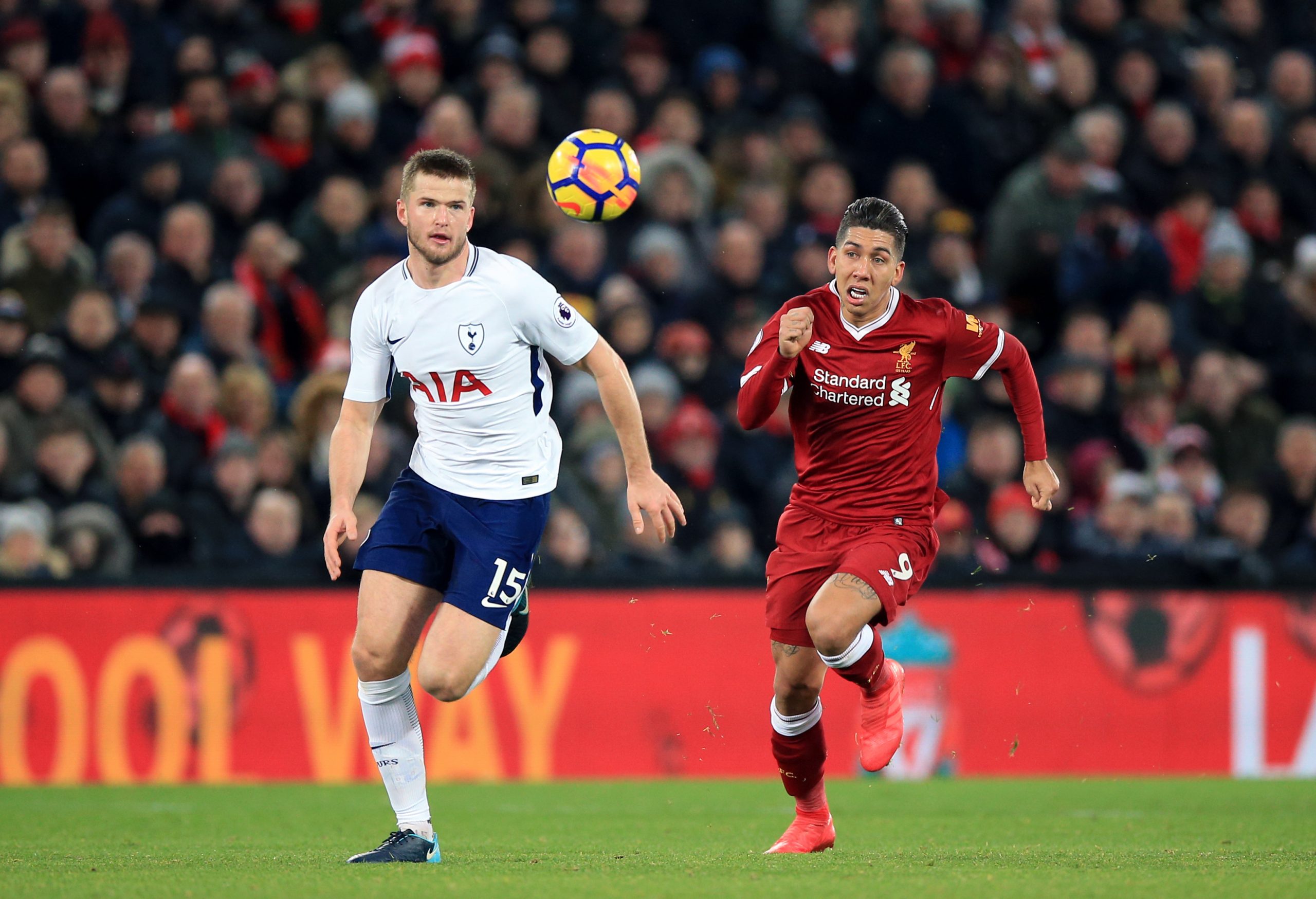There’s no doubt that Tottenham against Liverpool is the Premier League game of the weekend, but that doesn’t mean previous encounters haven’t felt somewhat flat. Since Jurgen Klopp arrived at Liverpool, he has faced Mauricio Pochettino’s Spurs six times in the league. Both sides have won one game fairly convincingly, while the other four have been drab, uninspiring draws. It’s as though both managers’ high pressing systems have a tendency to cancel out and create little in the way of goalmouth action. Even the most recent 2-2 draw was a very unentertaining affair for the first 75 minutes or so, before Victor Wanyama scored a screamer and Spurs won two penalties. The knowledge that both sides have had difficulties breaking down the other in the past may inform some of the choices the managers make here, such as:
Will Spurs Press High?
Pochettino’s only decisive victory against Klopp’s Liverpool came at Wembley last October, in which his side played on the counter to tear apart Liverpool and record a 4-1 win. Liverpool commande 64% possession and a comparable shot total to Spurs, but one side was able to generate much higher quality chances than the other. 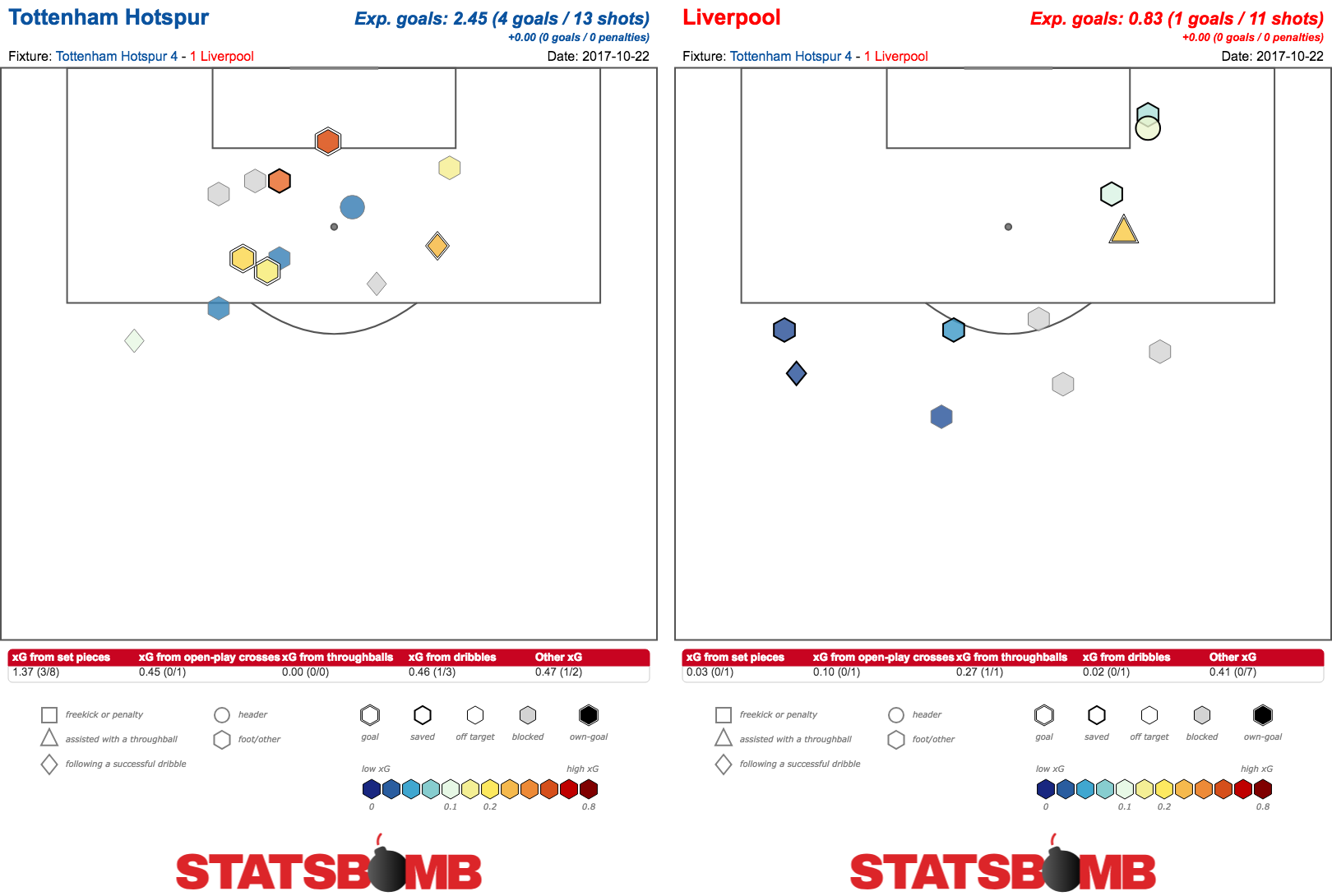 The way they did it was in a drastic shift from their usual plan. As shown from StatsBomb’s pressure numbers, they barely pressed in the opposition half at all.
The way they did it was in a drastic shift from their usual plan. As shown from StatsBomb’s pressure numbers, they barely pressed in the opposition half at all.  It was this defensive tactic that allowed them to hit Liverpool, who left a lot of space in behind, so effectively. In fact, they didn’t allow Klopp’s men almost any chances to press them at all.
It was this defensive tactic that allowed them to hit Liverpool, who left a lot of space in behind, so effectively. In fact, they didn’t allow Klopp’s men almost any chances to press them at all. 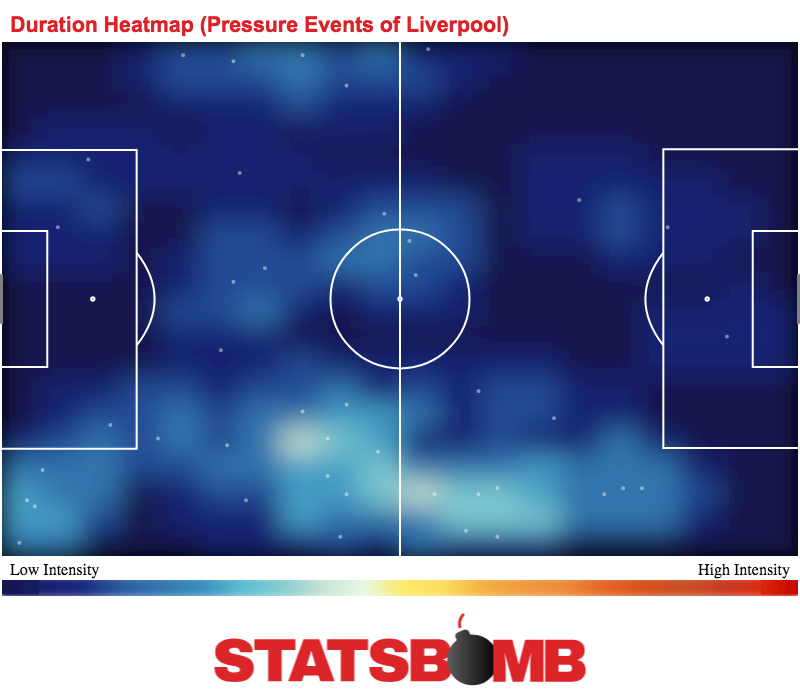 Liverpool did seem to wise up to this significantly in the return fixture the following February, and became much more compact themselves. As for Spurs, they haven’t exactly followed that path so far this season. On average they allow the opponent to make only 7.88 passes before making a defensive action; this is the fewest passes per defensive action in the league. Their high press rating (based on StatsBomb’s pressing data) is the third highest. Thus far in the season, this is not a side that has sat back. Whether Pochettino reverts to this strategy is perhaps the key unknown that Klopp will have to contend with.
Liverpool did seem to wise up to this significantly in the return fixture the following February, and became much more compact themselves. As for Spurs, they haven’t exactly followed that path so far this season. On average they allow the opponent to make only 7.88 passes before making a defensive action; this is the fewest passes per defensive action in the league. Their high press rating (based on StatsBomb’s pressing data) is the third highest. Thus far in the season, this is not a side that has sat back. Whether Pochettino reverts to this strategy is perhaps the key unknown that Klopp will have to contend with.
Who Starts in Midfield for Liverpool?
Unlike Spurs, who have adopted a range of different systems this season, Liverpool’s team largely picks itself at the moment. The formation will be 4-3-3. The attackers will be Sadio Mane, Mohamed Salah and Roberto Firmino. The back four will probably be Trent Alexander-Arnold, Joe Gomez, Virgil van Dijk and Andy Robertson, though there is an outside chance of Nathaniel Clyne or Joel Matip being rotated in. The only serious question is in midfield. For the first three games of the season, Gini Wijnaldum started as the deepest midfielder, a role he is not accustomed to, with Naby Keita and James Milner in front. Wijnaldum is a slightly strange if not entirely ineffective fit for the role. His 2.53 possession-adjusted tackles and interceptions per 90 minutes this season are well below what we’d expect from a defensive midfielder at a top side, and while it has not yet led to conceding significant chances, a minor flaw for Liverpool so far has been that teams have been able to move the ball through the centre of midfield without a lot of difficulty. Jordan Henderson came into the side against Leicester, with Wijnaldum moving further forward and Keita rested (though one imagines he will return to the side) presumably to better deal with this, but the result was not hugely different to before. Liverpool still allowed Leicester a number of decent counter-attacking opportunities, though it again only led to 0.82 expected goals. Expensive summer signing and specialist holding midfielder Fabinho remains unused, with his absence from Liverpool over the international break making it possible this will remain the case for another game. The most likely outcome is that Henderson starts, though there does not currently look to be an ideal option to offer Liverpool the defensive control from midfield the side craves.
Can Spurs Fix the Right Side, or can Liverpool Exploit It?
Spurs have a defensive issue. As James Yorke has written for StatsBomb, “across the last ten to fifteen fixtures, Tottenham’s expected goal production has been roughly equal in attack and defence. The attack side has been largely good, the defence has not”. Yorke points out that this issue has been specifically one down Spurs’ right side, with a large number of the chances they concede being created in this area: 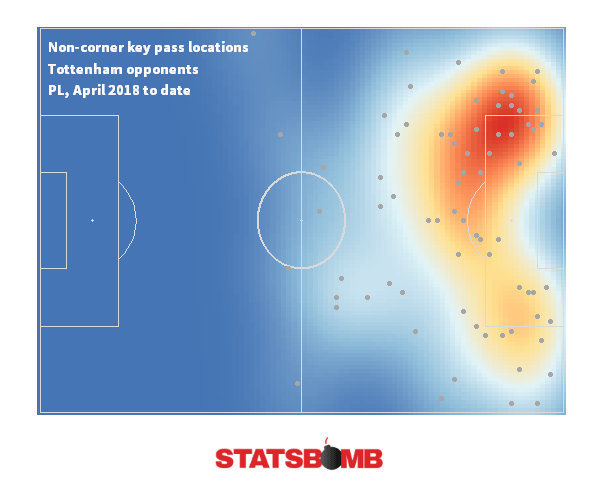 Usual right back Kieran Trippier appears to be particularly culpable, and thus a change may be wise. If there’s one thing associated with Jurgen Klopp’s Liverpool, it is pace, with Mane on the left flank a key part of that. Serge Aurier, a player not without his flaws but certainly someone much quicker than Trippier, could make a return to the starting eleven to plug this hole. Conversely, it is something Liverpool may well look to exploit. Mane has started the season in excellent form, with 4 goals in 360 minutes. On the same side, Robertson is currently assisting 0.36 expected goals per 90, an outrageous figure for a full back, while star creative midfield force Keita has had a tendency to drift left in his appearances so far. If Spurs don’t find a way to get this locked down, it could easily be something that Liverpool create a lot of chances from.
Usual right back Kieran Trippier appears to be particularly culpable, and thus a change may be wise. If there’s one thing associated with Jurgen Klopp’s Liverpool, it is pace, with Mane on the left flank a key part of that. Serge Aurier, a player not without his flaws but certainly someone much quicker than Trippier, could make a return to the starting eleven to plug this hole. Conversely, it is something Liverpool may well look to exploit. Mane has started the season in excellent form, with 4 goals in 360 minutes. On the same side, Robertson is currently assisting 0.36 expected goals per 90, an outrageous figure for a full back, while star creative midfield force Keita has had a tendency to drift left in his appearances so far. If Spurs don’t find a way to get this locked down, it could easily be something that Liverpool create a lot of chances from.
Are Liverpool Now Counter Attack-Proof?
In the aforementioned edition of this fixture last season, Spurs picked Liverpool apart on the counter. While it was somewhat surprising for Spurs to switch to that approach, there was nothing surprising about it being effective against Liverpool. The consensus among pretty much everyone was that Liverpool were hilariously open at the back, had a tendency to switch off at these moments and, as the harshest critics claimed, “couldn’t defend”. A quick look at the team’s rolling xG conceded since that game shows that things have changed a fair amount. 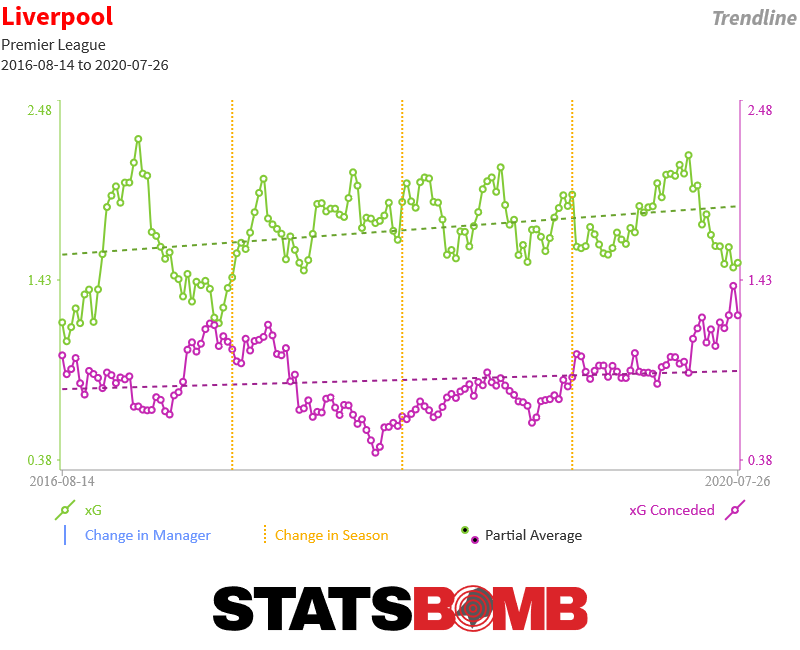 Spurs created 2.45 non-penalty expected goals against Liverpool that day. In the eleven months since, there hasn’t been a single Premier League game in which Liverpool have conceded more than 2. This is a team that “can defend”. What’s interesting is that this has been done without a huge change in strategy. Liverpool still play in largely the same way, and still attack in the same way, just without the defensive issues that plagued the side before. The arrival of Van Dijk was widely heralded as a major component in this shift, as was the signing of Robertson and the emergence of youngsters Gomez and Alexander-Arnold. Of this first choice back four, only one featured at Wembley last October. The feeling among many was that the individuals couldn’t possibly be that bad and clearly there was a systemic problem, but maybe it simply was the players not being up to task. Perhaps more work on the training ground led to the team finally grasping what was being asked of them. We may never know. If Spurs attempt the same counter-attacking strategy that worked so well last year, we should have a fairly interesting test case around how much this defence has actually improved.
Spurs created 2.45 non-penalty expected goals against Liverpool that day. In the eleven months since, there hasn’t been a single Premier League game in which Liverpool have conceded more than 2. This is a team that “can defend”. What’s interesting is that this has been done without a huge change in strategy. Liverpool still play in largely the same way, and still attack in the same way, just without the defensive issues that plagued the side before. The arrival of Van Dijk was widely heralded as a major component in this shift, as was the signing of Robertson and the emergence of youngsters Gomez and Alexander-Arnold. Of this first choice back four, only one featured at Wembley last October. The feeling among many was that the individuals couldn’t possibly be that bad and clearly there was a systemic problem, but maybe it simply was the players not being up to task. Perhaps more work on the training ground led to the team finally grasping what was being asked of them. We may never know. If Spurs attempt the same counter-attacking strategy that worked so well last year, we should have a fairly interesting test case around how much this defence has actually improved.
What Formation Will Pochettino Use?
In their opening game of the season, Spurs were broadly in a 4-2-3-1 shape, with Dele Alli and Lucas Moura playing narrow in the wide roles. For the following game against Fulham, they played a 3-5-2 shape, switching to three centre backs and having Alli and Christian Eriksen in “free eight” roles advanced of Eric Dier, with Lucas Moura as a support striker alongside Harry Kane. Against Manchester United, Pochettino returned to the back four, and initially played a diamond in midfield (with Mousa Dembele as the holding midfielder) before adjusting in game to a sort of 4-2-2-2, with Eriksen and Alli behind the front two of Moura and Kane. For the most recent game against Watford, Pochettino changed it back to the 3-5-2 shape, with the only personnel change from the last time it was rolled out against Fulham being Dembele for Dier. It has become something of a guessing game as to how the manager will set up his side, perhaps just as a genuine tailored strategy for each opponent, or perhaps as he finds different solutions to fix his side’s defensive issues. If it is the latter, the back three may be tempting as a way to address Trippier’s aforementioned struggles. If it is the former, however, this is less likely considering Liverpool’s penchant to crack back threes open with the pace and movement of Mane, Salah and Firmino. A back four may be more likely, especially considering the troubles the team had against Watford. The absence of Alli and return of Son Heung-min, who is unlikely to be able to play such a free eight role, is another thing Pochettino will have to contend with, perhaps making the 3-5-2 even less likely.
Will We Actually Get an Entertaining Game?
As discussed at the start of the article, these contests have not typically been a good watch for the neutral. On the few occasions that they haven’t been drab draws, we’ve instead had one sided contests. There are some reasons for optimism, though. Both sides have had some midfield control issues, with none of Gini Wijnaldum, Jordan Henderson, Eric Dier or Mousa Dembele performing the holding midfield role at a high level this season. Spurs’ right sided defensive problems persist, while Liverpool look particularly dangerous on that side. Perhaps we might finally get a game worthy of these two excellent sides.
